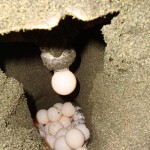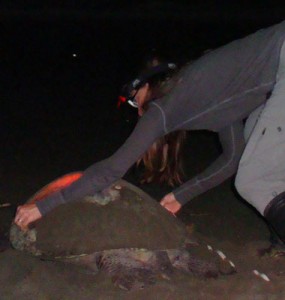 It’s the middle of the night and we walk in silence. Headlamps are off; our eyes have adjusted to the darkness. To the left, the rainforest silhouette rises to meet a star-studded horizon. On the right, the Pacific Ocean stretches like a rough floor waxed with moonshine. I am mesmerized by the wet sand beneath my feet, which sparkles like fairy dust. Every step incites a cluster of microscopic organisms stranded when the tide dropped, rousing them to flash their blue-white light called bioluminescence. The glittering effect is nothing short of magic.
It’s the middle of the night and we walk in silence. Headlamps are off; our eyes have adjusted to the darkness. To the left, the rainforest silhouette rises to meet a star-studded horizon. On the right, the Pacific Ocean stretches like a rough floor waxed with moonshine. I am mesmerized by the wet sand beneath my feet, which sparkles like fairy dust. Every step incites a cluster of microscopic organisms stranded when the tide dropped, rousing them to flash their blue-white light called bioluminescence. The glittering effect is nothing short of magic.
I am with Manuel, a 20-something Tico who has been working with Friends of the Osa since he was a boy. We talk and laugh readily in the airiness of day, but during our nightly outings we wear dark clothing and speak rarely and softly, murmuring in Spanish only when necessary. We are looking for sea turtles—specifically females who have come ashore to lay eggs. Sometimes we see them emerging from the rolling tide or lumbering up the beach. But more often we discover their tracks, shadowy streaks carved into flat sand like monster truck treads.
Two lines of tracks mean a turtle has already come… and gone. We measure the tracks and mark the nest at the apex, securing the site with a protective metal screen tapped into the sand with tire-iron spikes.
But a single track promises a giant shelled mother is still on the beach. Our job is to aid conservation research by collecting data about her and her nest. We are careful not to trouble the sea turtle before she has committed to nesting. Disturbed by light or commotion before dropping eggs, she will likely abandon her endeavor and shuffle back to the safety of the sea. If she is still climbing or digging, we wait, out of sight. But once she has finished excavating and started depositing leathery eggs into the cavity, we snap on our red headlamps, quietly approaching from behind to begin our tasks.
We measure the width and length of her carapace (top shell) as well as the width of her tracks. And, if she doesn’t have them, we attach numbered metal tags to her front flippers as gently as possible. They pierce the thin skin between digits and affix like earrings. The tag numbers are put in a data base so she can be identified in the future. Of course, if we find a turtle who already has tags, we log that into our field notebook, too. We also write down the date, time, tide level. And details about where the nest is, like which sector of the beach it’s in, how close to the waterline, how close to the trees, and gobs of other informational bites about the scenario. All of this is handled calmly and efficiently to limit stress to the turtle and we are done in a few minutes. After the female has delivered her precious packet to the land, she ambles back to the soothing lap-and-pull of the waves. This, her return to the aquatic world, is always observed in reverent silence.
Some nights we see several turtles. Some nights we see none. Mostly we walk, absorbing the peaceful bounty of this nocturnal wonderland. We listen to the surf curl into itself, the steady rhythm of ocean music. We search a trillion stars for familiar constellations. Then, as the tide inches up the beach to wipe away our steps, we bid farewell to the sea breeze and slip into the sultry rainforest the way we came. Back at the OBC our bunks await, sure to carry us from waking dreams of motherly sea turtles and fairy dust sand to… sweet… deep… sleep.



